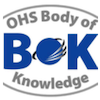Chapter 31.2: OHS Risk and Decision Making
Abstract
Risk management is part of organisational decision-making with poor decision-making about risk being a factor in workplace fatality, injury, disease and ill-health. Generalist Occupational Health and Safety (OHS) professionals can influence decision-makers to make informed choices about risk. To do so they need to understand the nature of risk and its inherent uncertainty and how decisions are made in organisations and by individuals, and the factors influencing such decisions. This chapter examines decision-making theory, types of organisational decisions and factors influencing decisions about risk. It considers risk communication, legal and ethical issues, and the limitations of risk assessments. The chapter concludes with an examination of the role of the OHS professional in influencing risk-based decision-making, and presentation of a model to inform OHS professional practice.
Keywords: risk, risk management, decisions, decision-making, influence, uncertainty, occupational health and safety, OHS, risk information, risk communication
First year of publication: 2015
Current Version: 2019
Chapter 31.2: OHS Risk and Decision Making
Table of contents
| 1 | Introduction |
| 1.2 | Types of decisions |
| 2 | Moral, ethical and legal issues |
| 3 | The theory of decision-making |
| 3.1 | Classical decision-making |
| 3.2 | Naturalistic decision-making |
| 3.3 | Sensemaking |
| 3.4 | Efficiency – Thoroughness Trade- Off (ETTO) |
| 3.5 | Rules, procedures and decisions |
| 4 | Factors influencing decisions about risk |
| 4.1 | Mental models and knowledge |
| 4.2 | Communication |
| 4.3 | Contextual factors |
| 4.4 | Structural features within an organisation |
| 4.5 | Organisational behaviour |
| 4.6 | Summary |
| 5.1 | Risk matrices |
| 6 | Implications for OHS practice |
| 6.1 | Giving advice |
| 6.2 | Influencing operational decision-making |
| 6.3 | Influencing strategic and tactical decisions |
| 6.4 | Working with SMEs |
| 6.5 | A proposed model for encouragement of risk-based decision-making by OHS professionals |
References
Appendix 1: Expert input and consultation
Carmel Bofinger BSc, MECH, CPMSIA
Associate Professor, Minerals Industry Safety and Health Centre, University of Queensland
Carmel has provided expert assistance in risk management and health and safety management systems to the mining and other industries for more than 20 years. Her current role at the Minerals Industry Safety and Health Centre involves education, project work and research in risk management and health and safety.
Jan Hayes PhD, MBus, BE(Hons)
Senior Researcher and Program Leader, RP4 Public Safety and Security of Supply, Energy Pipelines CRC, Australian National University
Jan has 30 years’ experience in safety and risk management. Her research interests focus on organisational safety and effective regulation, particularly decision-making, story-based learning and professional expertise. Jan is a member of the Advisory Board of the National Offshore Petroleum Safety and Environmental Management Authority.
Chris Bearman PhD, MSc, BSc(Hons) Research Fellow,
Appleton Institute, Central Queensland University
Chris has worked closely with industry partners and government organisations around the world to produce research that has both a strong theoretical underpinning and a robust application to industry. Chris conducts industry-focused research on decision-making in the areas of occupational health and safety, human factors and applied cognitive psychology.
Derek Viner
Consulting Risk Engineer
Derek is a consulting risk engineer and management consultant in risk control who has been instrumental in developing the academic disciplines of accident phenomenology and risk philosophy through his continuous involvement in post graduate in risk and safety.
Learning Outcomes
The OHS Body of Knowledge takes a conceptual approach which enables it to be applied in different contexts and frameworks. To optimise its value for education and professional development learning outcomes have been developed for each technical chapter in the Body of Knowledge.
The learning outcomes as described give an indication of what should be the capabilities of a new graduate OHS professional in the workplace. I t is up to those developing OHS education programs, OHS professionals planning their CPD or recruiters or employers selecting or developing people for the OHS function to consider the required breadth vs. depth
Videos
SWA Videos – Effective work health and safety risk management
In this video Derek talks about the need to both identify risks and maintain a risk inventory to track them long-term. He also discusses managing risks using a hazard management plan, understanding levels of control, and the need for different approaches to managing general and operational risks.
Date: 2019
Presenter/s: Derek Viner
Source: https://www.safeworkaustralia.gov.au/media-centre/effective-work-health-and-safety-risk-management
Video – Risk and decision-making
Carmel speaks on behalf of other authors on the development of the OHS BoK chapter on Risk and decision-making.
Date: 2015
Presenter/s:Carmel Bofinger
Source: https://www.youtube.com/watch?v=W1uBN_YqUVA
Webinars
AIHS Webinar: Risk competency to improve safety
This webinar introduces the theory and evidence behind human expertise development, the strength of intuitive decisions, and what we can do practically to leverage this for better safety outcomes. Moving beyond the ‘mechanics’ of decision-making it touches on: the role of culture, beliefs, and emotions in safety behaviours; human error and just culture; safety leadership; and how all this can create ‘risk competency’ in frontline workers.
Date: 2021
Presenter/s: Tim Lawler
Source: https://youtu.be/8U5W5oen4rI
Books
FONCSI: Risk informed decision-making processes
This book presents an introduction to risk-informed decision-making, along with a description of the manner in which the technique has been implemented by the NASA and by the US NRC for the regulation of nuclear activities. It also documents the respective advantages and disadvantages of deterministic and probabilistic approaches to risk assessment
Date: 2012
Presenter/s:Enrico Zio & Nicola Pedroni
Source: https://www.foncsi.org/en/publications/collections/industrial-safety-cahiers/risk-informed-decision-making-processes/CSI-RIDM.pdf

